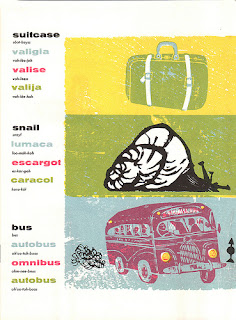The house that Jack built, de Randolph Caldecott, edição original de 1878 (George Routledge&Sons, EUA).
Quando começámos a fazer livros, para
além daquele conhecimento próprio de quem se interessa pelo assunto, não
conhecíamos grandes detalhes sobre a história do álbum ilustrado. Aos poucos,
vamo-nos apercebendo do património imenso que herdámos e sempre que fazemos uma
descoberta nova (por ex. um autor ou ilustrador que não conhecíamos) ficamos
perplexos: afinal já outros antes de nós por aqui andaram, se debateram com
problemas semelhantes aos nossos, inventaram soluções e novas formas trabalhar. Todos eles sentiram, certamente, poder
ter algo a acrescentar aos livros que já existiam, e fizeram-no trazendo para
os seus textos e imagens novas preocupações e, atrás delas, novas ideias,
grandes livros.
Ilustrações de Edy-Legrand para o livro Macao et Cosmage, editado em 1919 (Ed. Nouvelle Revue Française).
Uma descoberta interessante: as
mudanças tecnológicas sempre acompanharam — e em muitos casos até ditaram — as
grandes revoluções na produção de livros. Foi assim com a introdução da cor ou
com as técnicas de impressão que foram permitindo uma relação mais flexível
entre o texto e a imagem.
Outra descoberta interessante: já
houve outras crises antes desta, momentos em que foi necessário aproveitar os
recursos ao máximo, procurando, por exemplo, formatos que permitissem
rentabilizar os custos.
See and Say, de Antonio Fransconi, edição original de 1955 para Harcourt Brace (EUA).
Muitos dizem que esta crise é diferente das outras (a história repete-se mas nunca é a mesma). Há muitas incertezas também no mundo da edição, ao ponto de nos questionarmos se, num futuro não muito longínquo, continuará a haver livros em papel. Não sabemos e, como quase tudo hoje em dia, talvez isso dependa única e exclusivamente “dos mercados". Ninguém sabe. Mas enquanto o futuro paira no ar, aqui estaremos todos os dias— como já muitos antes de nós o fizeram— a trabalhar e a matutar, concentrados no essencial (e mais saboroso): tudo o que pomos dentro dos livros.
How did we get here?
When we started making books, we didn't know much
about the history of illustrated books, apart from the general knowledge
of all readers with an interest in this subject. But gradually we are realizing our immense heritage and
are amazed each time we make a new discovery: at
the end of the day, somebody else had already been here, struggled with
similar problems and tried to find new
solutions. All those who came before us certainly felt
that they had something to add to the books that already existed, and they did so, bringing
new concerns and new ideas to their texts
and images.
An interesting discovery is that technological
change has always gone hand in hand with major developments in book production – in many cases even shaping those revolutions.
This was the case with the introduction
of color or with printing
techniques, which allowed for a more flexible relationship between text and image.
Another interesting discovery is that the current crisis is not the first of its kind: other crises have occurred, times when resources needed to be used as effectively as possible and solutions were needed that would provide publishers with good value for money.
Another interesting discovery is that the current crisis is not the first of its kind: other crises have occurred, times when resources needed to be used as effectively as possible and solutions were needed that would provide publishers with good value for money.
Many say that this crisis is different from the others (history repeats itself but is never entirely the same). The
publishing world also has to deal with markets and uncertainty and
nobody knows what will happen. But
while the future is uncertain, we will be here every
day – as many have been before us – thinking and working, fully focused on what we put in our books. This is
central to what we do – and also what we
most relish.











1 comentário:
viva o passado, viva o presente, viva o futuro, viva este planeta
Enviar um comentário